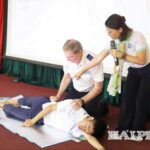Drowning is the process of respiratory failure (basically difficulty breathing) due to water in the airways and lungs.
So what is drowning on land?
- “Dry drowning” refers to complications that can arise after a person drinks water through the nose and/or mouth but does not enter the lungs, causing spasms that block the airways. Dry drowning often occurs immediately after exiting the water because the water touches the upper respiratory tract and causes spasm of the epiglottis leading to cardiac arrest. Research has shown that “dry drowning” has been observed during autopsies in 10% to 15% of drowning caeses in the United States.

- “Secondary drowning” occurs when small amounts of water enter the lungs, leading to inflammation or swelling. The body has difficulty exchanging air properly through the lungs, which can lead to a buildup of carbon dioxide (CO2) and dangerously low levels of oxygen (O2). In the case of secondary drowning, it can take up to 24 hours before the person shows signs of distress.
Drowning on land is rare but can still occur if the following symptoms are not promptly recognized:
- Shallow or labored breathing: Rapid, shallow breathing, flaring nostrils, or visible space between your child’s ribs or space above the collarbone when he breathes means your child is trying harder than usual to breathe. If you notice these symptoms, you should seek medical help immediately.
- Cough: A persistent cough – or a cough that involves increased breathing – should be evaluated.
- Vomiting: Kathleen Berchelmann, MD, a pediatrician at St. Louis and Washington, explains: “Vomiting is a sign of stress on the body caused by inflammation and sometimes lack of oxygen, as well as by persistent coughing and vomiting.”
- Excessive fatigue or sleepiness: Did your child just have fun playing in the pool and now they appear tired? That could mean they’re not getting enough oxygen into their blood. Do not put your child to sleep until medical staff give you permission. A day of water fun can be fun for the kids, but it’s best to exercise extreme caution if any type of water rescue is involved.
- Behavioral changes: If your child is acting more forgetful or not acting like themselves, it may indicate there has been a change in their oxygen status. Likewise, reduced oxygen levels can make your child feel tired or dizzy.

To avoid the risk of drowning, the first rule is to always keep safe
- For young children, adult supervision is always required when playing near water.
- In addition, learning how to swim and knowing how to handle dangerous situations near water is also very important.
- Eliminate the risk of drowning: Household water containers such as wells and jars must have lids and be carefully covered; The swimming pool must be securely and securely latched.
- Consider taking at least 1 of the following classes:
- Basic first aid or Cardiopulmonary resuscitation (CPR) because this is a proven effective first aid method when drowning occurs.
- Drowning prevention to learn how to prevent drowning victims from drowning, bring victims to shore safely and perform first aid properly.
- Do not let young children play in water because there is a very high risk of drowning if they are not constantly supervised and supervised by an adult.
- Comply with safety measures when participating in water transportation and when swimming.
If you or someone else suspects a drowning situation on land or after bathing, swimming or choking on water, if you have the above symptoms, you should immediately go to the nearest medical facility for timely examination and intervention. Remember that one minute of delay can have serious consequences.
Let’s spread knowledge about the risk of drowning together, so that every time we come into contact with water, we can participate in the safest and most fun way.






